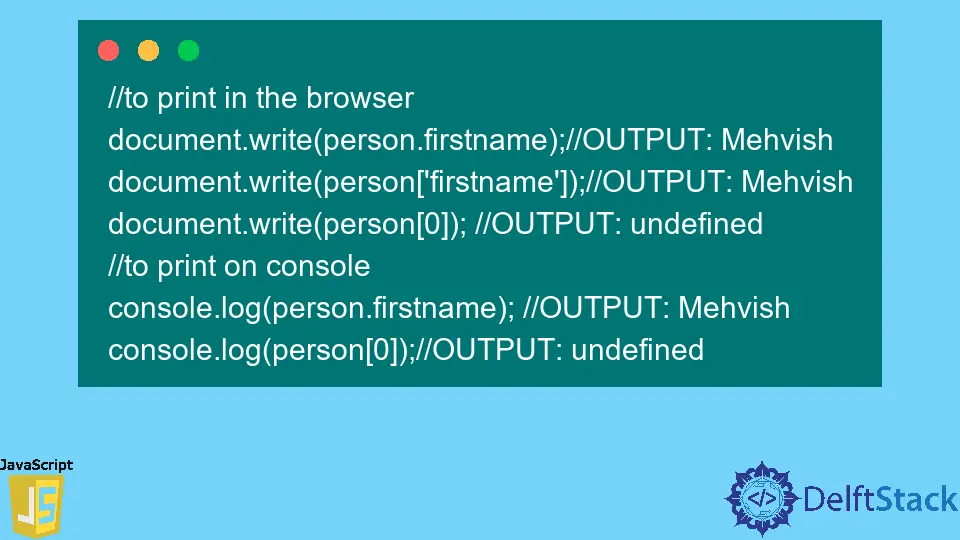JavaScript 关联数组和哈希表

我们将学习如何使用对象和 Map() 实现 JavaScript 关联数组和哈希表。
尽管 JavaScript 除了对象之外没有关联数组/哈希表。但是还有其他方法可以做到这一点。
在深入了解详细实现之前,有必要了解关联数组、映射、字典和哈希表之间的区别。虽然这些都是用来保存键值对数据的,但还是有区别的。
- 关联数组是一种数据结构概念,包含(键、值)对中的数据。它也被称为抽象数据类型,就像 Map 和字典一样。这里的索引是字符串,而不是整数。有不同的方法来实现关联数组;哈希表就是其中之一。
- 字典还保存(键,值)对中的数据,与关联数组相同。但是,它的索引是整数。
- Map 也有键值对的数据。它会记住键的原始插入顺序。
- 哈希表就是使用哈希方法在内存中排列数据。它是模拟关联数组的方法之一。
使用对象创建 JavaScript 关联数组
// first way to create associative array
const person = [];
person['firstname'] = 'Mehvish';
person['lastname'] = 'Ashiq';
person['age'] = 30;
person['city'] = 'Multan';
person['email'] = 'delfstack@example.com';
// second way to create associative array
const person = {
firstname: 'Mehvish',
lastname: 'Ashiq',
age: 30,
city: 'Multan',
email: 'delfstack@example.com'
};
我们在上面的代码中创建了一个用作关联数组的 JavaScript 对象。firstname、lastname、age、city 和 email 是键(索引)。这些值是 Mehvish、Ashiq、30、Multan、delfstack@example.com。
假设我们要添加一个新的键值对作为 phone:12334567。为此,我们可以使用 Object.assign() 函数。它将第二个对象复制到第一个对象的末尾。
// Here the second object is {phone:12334567}
// Here the first object is person
Object.assign(person, {phone: 12334567});
我们可以通过定位键(索引)来访问每个键的值。请记住,索引是字符串,而不是数字。所以,你不能在这里像 person[0] 一样访问(如果你使用字典,你可以使用 person[0])。
// to print in the browser
document.write(person.firstname); // OUTPUT: Mehvish
document.write(person['firstname']); // OUTPUT: Mehvish
document.write(person[0]); // OUTPUT: undefined
// to print on console
console.log(person.firstname); // OUTPUT: Mehvish
console.log(person[0]); // OUTPUT: undefined
我们可以使用 for 循环打印完整的关联数组。
// print complete associative array using for look
for (var key in person) {
var value = person[key];
document.write(value);
document.write(' ');
}
输出:
"[firstname: Mehvish]"
"[lastname: Ashiq]"
"[age: 30]"
"[city: Multan]"
"[email: delfstack@example.com]"
"[phone: 12334567]"
打印整个关联数组的更优化方法是 Object.entries() 方法,它采用对象数据类型的一个参数。你可以阅读 this 了解更多 Object 的功能。
// print complete associative array using for look
let completeAssociateArray = Object.entries(person);
console.log(completeAssociateArray);
输出:
[["firstname", "Mehvish"], ["lastname", "Ashiq"], ["age", 30], ["city", "Multan"], ["email", "delfstack@example.com"], ["phone", 12334567]]
使用 Map() 函数创建 JavaScript 关联数组
// first way to create associative array using Map function
const person = new Map();
person.set('firstname', 'Mehvish');
person.set('lastname', 'Ashiq');
person.set('age', 30);
person.set('city', 'Multan');
person.set('email', 'delfstack@example.com');
// second way to create associative array using Map function
const person = new Map([
['firstname', 'Mehvish'], ['lastname', 'Ashiq'], ['age', 30],
['city', 'Multan'], ['email', 'delfstack@example.com']
]);
使用 get(key) 方法,我们可以获得一个特定的值。
person.get('city'); // output is "Multan"
显示整个关联数组键值对。
for (const [key, value] of person.entries()) {
console.log(key + ' = ' + value)
}
输出:
"firstname = Mehvish"
"lastname = Ashiq"
"age = 30"
"city = Multan"
"email = delfstack@example.com"
使用 keys() 函数仅打印键。
for (const key of person.keys()) {
console.log(key)
}
输出:
"firstname"
"lastname"
"age"
"city"
"email"
仅使用 values() 函数获取值。
for (const value of person.values()) {
console.log(value)
}
输出:
"Mehvish"
"Ashiq"
30
"Multan"
"delfstack@example.com"
我们可以使用 delete(key) 删除一个元素;如果成功删除,则返回 true。如果元素与给定键相关联,则 has(key) 返回 true,而 clear() 删除所有键值对。
如需详细了解,你可以访问这页面。如果你正在寻找哈希表的实现,你可以使用 Map() 函数,但我们使用 JavaScript 对象来实现哈希表。
使用 JavaScript 对象实现哈希表
var ht = new HashTable({firstname: 'Mehvish', lastname: 'Ashiq', age: 30});
function HashTable(person) {
this.size = 0;
this.item = {};
for (var p in person) {
if (person.hasOwnProperty(p)) {
this.item[p] = person[p];
this.size++;
}
}
this.set =
function(key, value) {
var previousItem = undefined;
if (this.has(key)) {
previousItem = this.item[key];
} else {
this.size++;
}
this.item[key] = value;
return previousItem;
}
this.get =
function(key) {
return this.has(key) ? this.item[key] : undefined;
}
this.has = function(key) {
return this.item.hasOwnProperty(key);
}
}
让我们使用以下代码对其进行测试。
console.log(ht.size);
console.log(ht.get('firstname'));
它给出了以下结果。
3
"Mehvish"
hasOwnProperty 用于检查键是否属于 item 对象。换句话说,如果给定的属性直接属于 item 对象,它返回 true。
set、get 和 has 只是 Object 函数的模仿形式。
